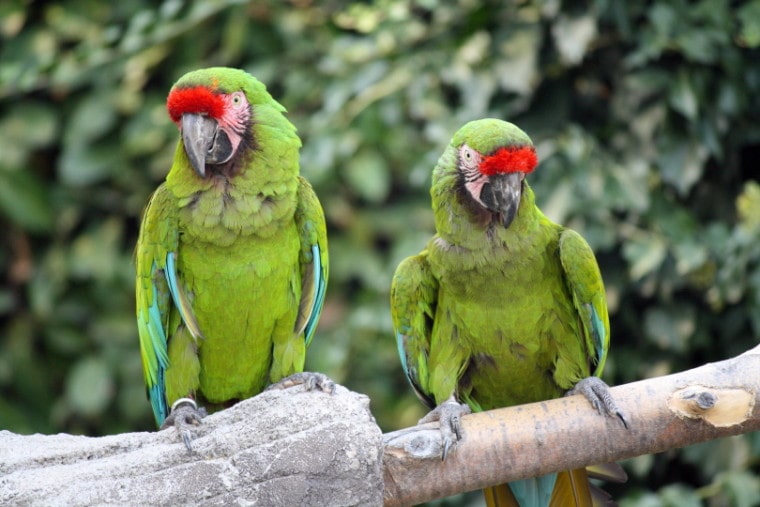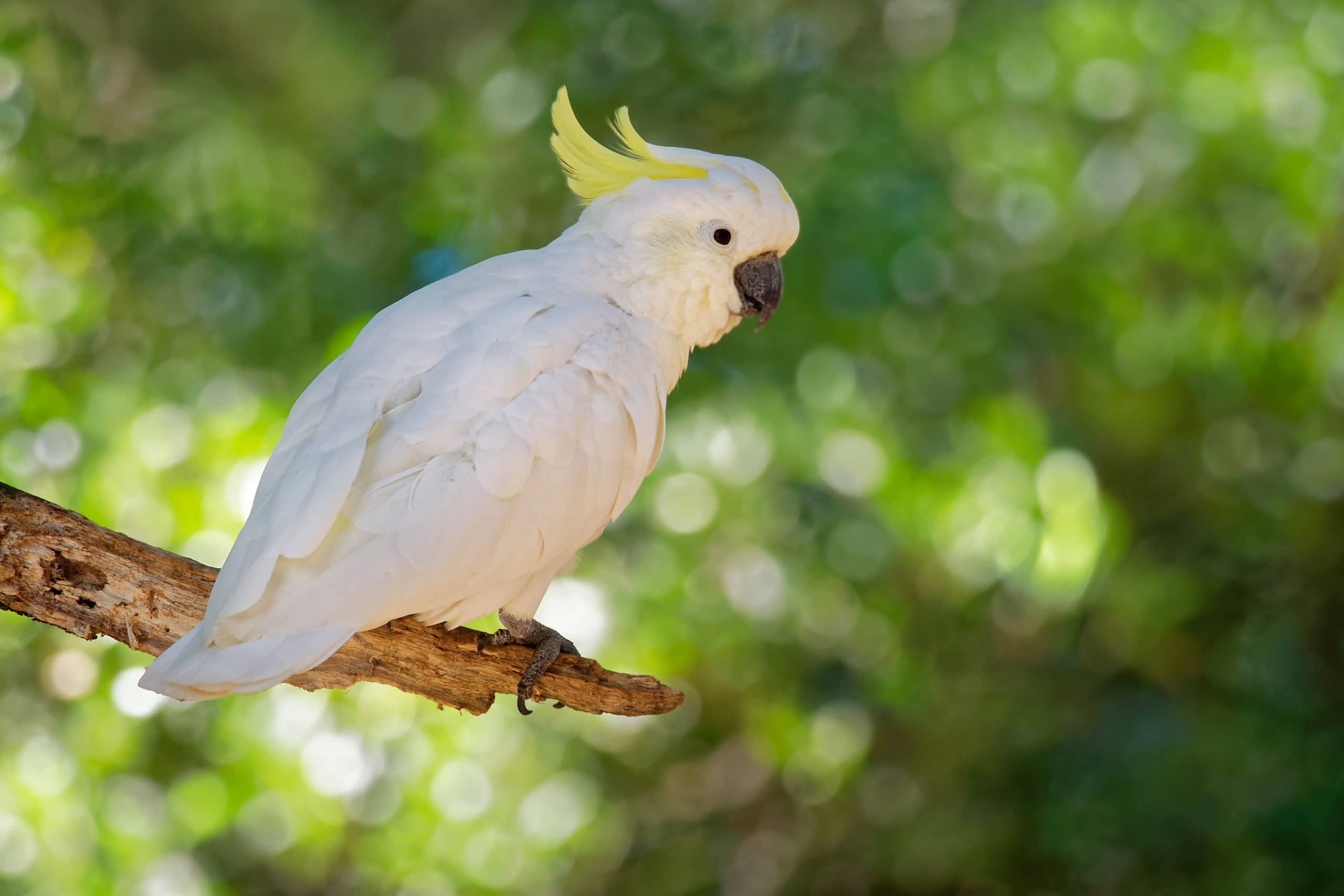
Macaws are among the largest parrots on the planet and are native to many of the rainforests and woodlands of South America. These large birds make wonderful pets because they are friendly, intelligent, and affectionate, although their large size makes them a challenging bird for novice owners. Military Macaws in particular are known for being even-tempered and docile parrots, and with their more laid-back temperament, they are better for less experienced bird owners.
The Military Macaw has long been a popular choice of pet by parrot enthusiasts because they are beautiful, comparatively docile, and breed readily in captivity. If you’d like to know more about this beautiful macaw, read on for an in-depth care guide.
Species Overview

| Common Names: | Military macaw, Bolivian military macaw, Mexican military macaw |
| Scientific Name: | Ara militaris |
| Adult Size: | 20-30 inches |
| Life Expectancy: | 40-60+ years |
Origin and History
Military Macaws are native to South America, mainly the high-altitude forests and woodlands of Mexico, Bolivia, and Columbia. These parrots prefer to live in more arid environments rather than rainforests, like many other parrot species, although they can be found living on the edges of humid forests at times. They have been popular as pets for hundreds of years and were named for their green plumage that resembled the military green uniform used during the time of their discovery.
Unfortunately, these birds are in danger of extinction in the wild due to trapping for the pet trade and loss of habitat, and they are now a protected species. There are an estimated 10,000 Military Macaws left in the wild, with this number dropping worryingly rapidly.
Temperament
Military Macaws are highly intelligent birds that are even-tempered and easy to tame. They are friendly and good-natured parrots that with adequate socialization, are social and friendly toward new faces. In the wild, they live in large flocks of up to 20 birds, so in captivity, they form strong bonds with their owners. While they are not known as the most affectionate parrots, they do enjoy the occasional cuddle with their owners.
Training a Military Macaw is generally an easy task, and they’ll enjoy the interaction, but they can get nippy at times, especially if they are not getting adequate interaction with their owners or enough mental and physical stimulation. They are playful birds that love to spend time with their family, so they require a large time investment of at least 3-4 hours per day of interaction to make sure they are happy and healthy.
Speech & Vocalizations
Military Macaws are generally quiet birds compared to other large parrots, although they are certainly capable of loud screeching and squawking if they are unhappy or seeking attention or want to show their excitement when their owner comes home. They are generally considered as one of the quieter macaw species, though they are still not suitable for apartments or homes with close neighbors.
They are not known for talking or mimicking sounds as well as other parrots, but they can learn a handful of words and short phrases with dedicated training. Once they learn to mimic a few words, they can be heard muttering those words to themselves quietly throughout the day.
Military Macaw Colors and Markings
Military Macaws are mostly green in color but are streaked with lighter green and yellow tones, with slightly lighter shades of green on their heads and necks. The wings and tails have bright blue edging, and their tails have additional reds and browns with light green-yellow coloring underneath. They have dark, almost black beaks, with distinctive red foreheads and white circles around their eyes.
Military macaws are monomorphic, meaning males and females look alike, and it’s exceedingly difficult to tell them apart. There are two sub-species of the Military Macaw that are slightly different in appearance:
Caring for the Military Macaw
The most important factor in owning a Military Macaw or any other large parrot is that spending time interacting with and giving attention to one of these birds is vital. They cannot be left alone for extended periods and will likely become depressed and even destructive and aggressive when they are lonely. They need a large cage — at least 3×3 feet wide and 5 feet tall — but need to spend plenty of time outside their cage too.
Macaws can live peacefully together, but they will likely end up breeding, so keep this in mind if you keep a male and female together. Two macaws of the same sex will likely fight, so in most cases, it’s best to keep macaws alone. Macaws do not usually get on well with other birds because they can be highly territorial at times, so if you have other birds or parrots at home, it is best to keep them separated.
Common Health Problems
Military macaws are hardy, long-lived parrots that with the correct care, can live long and healthy lives of 60 years and beyond. That said, they are prone to viral infections and overgrown beaks at times, so we recommend check-ups with an avian vet at least once a year to make sure your parrot is healthy. Also, you should take them to a vet if they start to exhibit any of the following symptoms:
Diet and Nutrition
High-quality, specially-made parrot pellets are the best staple diet for your macaw, with occasional seed mixes and fresh fruits and vegetables. In the wild, their diet consists of mostly the seeds, nuts, fruits, and berries found in their habitat, but commercial pellets are the best way to ensure that your pet macaw is getting adequate nutrition. Fruits and seeds should make up no more than 20-25% of their daily food intake.

Exercise
Macaws are active birds that need regular exercise on a daily basis. In the wild, these birds fly for miles every day and climb up and down the treetops foraging for food, so they need plenty of exercise to replicate this in captivity. In addition to having a large enough cage for them to climb and stretch their wings inside of, they need at least 3 hours outside of their cage every day too, although more is better. A large perch outside of their cage equipped with ladders, ropes, and swings is ideal.
Macaws love to chew, so bird-safe toys made from wood are ideal to save your bird from chewing on things around your home. Also, be sure to spend plenty of interactive time playing with your macaw, as this will keep them mentally engaged too.
Where to Adopt or Buy a Military Macaw
Military macaws are somewhat difficult to find because the more colorful varieties of macaws are far more popular in pet stores. They are readily bred in captivity, though, so there are reputable breeders around who may have one to sell. Depending on the breeder, availability, and age, these birds can go for $2,000-$2,500, before you even purchase a cage or accessories.
There are plenty of parrot rescue organizations and adoption agencies around that may have a Military Macaw that needs a home. Not only will you be giving a home to a bird in need, but it will also cost you far less than what you’d pay from a breeder.
Final Thoughts
The Military Macaw may not be as colorful as their close cousins, but they are beautiful, nonetheless. These birds are considered to be the quietest of the macaw parrots, so they are a better choice if constant noise bothers you. That said, they are not as adept at mimicking words as other macaws are, and they are generally not as affectionate either. They are far more docile and laidback, however, so if the thought of a needy, attention-seeking bird is not ideal, the Military Macaw may be a perfect choice for you.
Like any macaw species, the Military Macaw is a massive investment of time and responsibility that should not be taken lightly, but if you decide to take the plunge, they make wonderful pets indeed.
Featured Image Credit: Daniele C, Shutterstock








